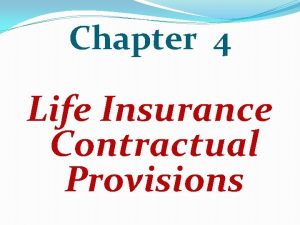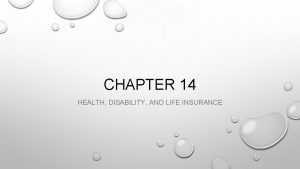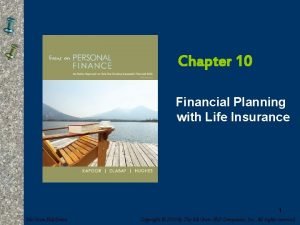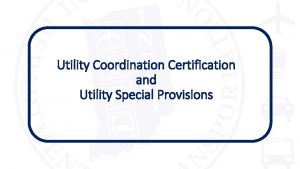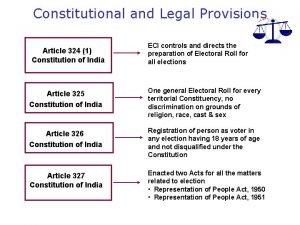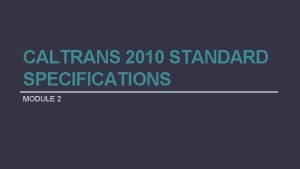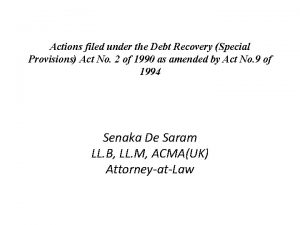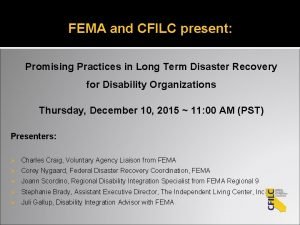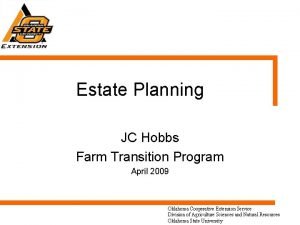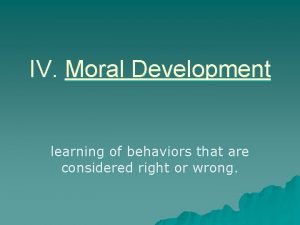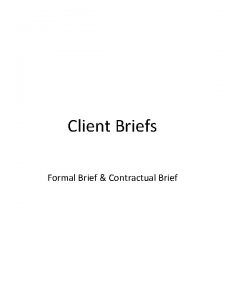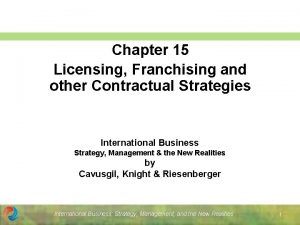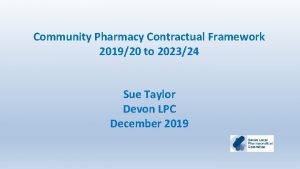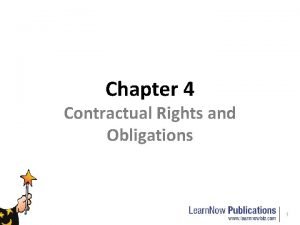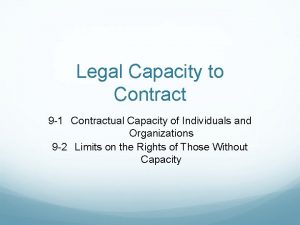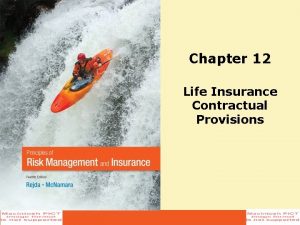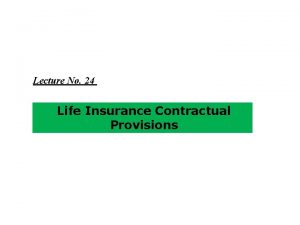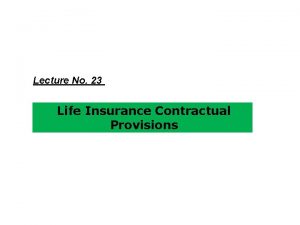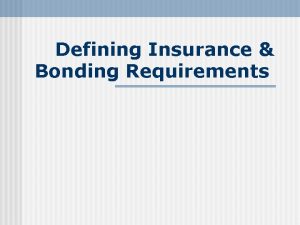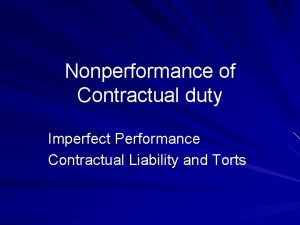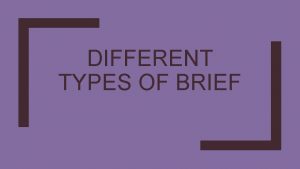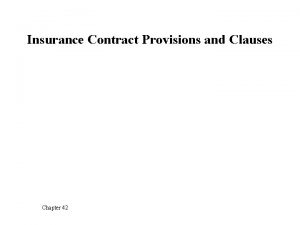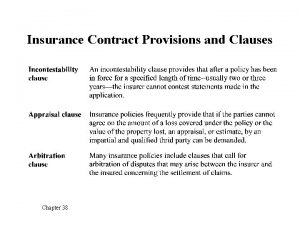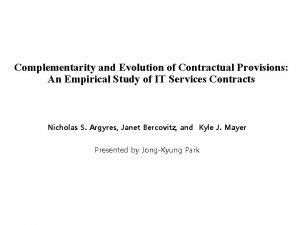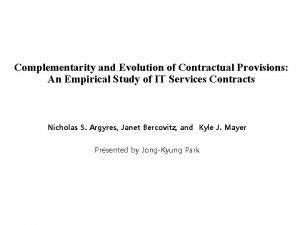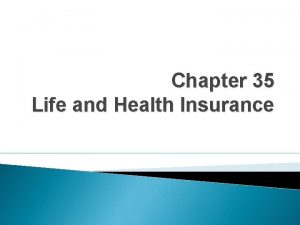Chapter 12 Life Insurance Contractual Provisions Copyright 2017
































- Slides: 32

Chapter 12 Life Insurance Contractual Provisions Copyright © 2017 Pearson Education, Ltd. All rights reserved.

Agenda • • • Life Insurance Contractual Provisions Dividend Options Nonforfeiture Options Settlement Options Additional Life Insurance Benefits

Life Insurance Contractual Provisions • Under the ownership clause, the policyholder possesses all contractual rights in the policy while the insured is living – Rights include naming beneficiaries and surrendering the policy for its cash value – The policyholder can designate a new owner by filing an appropriate form

Life Insurance Contractual Provisions (Continued) • The entire-contract clause states that the life insurance policy and attached application constitute the entire contract between the parties – Prevents the insurer from making amendments without the policyholder’s knowledge

Life Insurance Contractual Provisions (Continued) • The incontestable clause states that the insurer cannot contest the policy after it has been in force two years during the insured’s lifetime – Protects the beneficiary if the insurer tries to deny payment of the claim years after the policy was first issued – The insurer has two years to detect fraud – The insurer can contest a claim after the incontestable period in limited circumstances

Life Insurance Contractual Provisions (Continued) • The suicide clause states that if the insured commits suicide within two years after the policy is issued, the face amount of insurance will not be paid; there is only a refund of the premiums paid • A life insurance policy contains a grace period during which the policyholder has a period of 31 days (or more) to pay an overdue premium – The purpose of the grace period is to prevent the policy from lapsing

Life Insurance Contractual Provisions (Continued) • The reinstatement provision permits the owner to reinstate a lapsed policy • To reinstate a lapsed policy, the following requirements must be met: – Evidence of insurability is required – All overdue premiums plus interest are paid – Any policy loans are repaid or reinstated – The policy was not surrendered for its cash value • The policy must be reinstated within a certain period • Although it may require a large outlay of cash, it may be cheaper to reinstate a lapsed policy than to purchase a new policy

Life Insurance Contractual Provisions (Continued) • Under the misstatement of age or sex clause, if the insured’s age or sex is misstated, the amount payable is the amount that the premiums paid would have purchased at the correct age and sex

Life Insurance Contractual Provisions (Continued) • The beneficiary is the party named in the policy to receive the policy proceeds • The primary beneficiary is the first entitled to receive the policy proceeds on the insured’s death • A contingent beneficiary is entitled to the proceeds if the primary beneficiary dies before the insured

Life Insurance Contractual Provisions (Continued) • A revocable beneficiary means that the policyholder reserves the right to change the beneficiary designation without the beneficiary’s consent • An irrevocable beneficiary is one that cannot be changed without the beneficiary’s consent • A specific beneficiary is specifically identified • A class beneficiary is a member of a group, e. g. , children of the insured

Life Insurance Contractual Provisions (Continued) • A change-of-plan provision allows policyholders to exchange their present policies for different contracts • Life insurance contracts do not contain many exclusions – Suicide excluded for two years – Insurers might insert a war clause to exclude payment if the insured dies as a direct result of war – Some policies contain aviation exclusions • Premiums can be paid annually, semiannually, quarterly, or monthly

Life Insurance Contractual Provisions (Continued) • A life insurance policy is freely assignable to another party – Under an absolute assignment, all ownership rights in the policy are transferred to a new owner – Under a collateral assignment, the policyholder temporarily assigns a life insurance policy to a creditor as collateral for a loan, but only certain rights are transferred to the creditor

Life Insurance Contractual Provisions (Continued) • A policy loan provision allows the policyholder to borrow the cash value – The policyholder must pay interest on the loan to offset the loss of interest to the insurer – A policy could lapse if the policyholder does not repay a loan and the total indebtedness exceeds the available cash value – The major advantage of a policy loan is the relatively low rate of interest that is paid – The major disadvantage of a policy loan is that the policyholder is not legally required to repay the loan, and the policy might lapse if the indebtedness exceeds the available cash value

Life Insurance Contractual Provisions (Continued) • Under the automatic premium loan provision, an overdue premium is automatically borrowed from the cash value after the grace period expires – The automatic premium loan prevents the policy from lapsing because of nonpayment of premiums – It may be overused and exhaust the cash value – Proceeds will be reduced if the premium loans are not repaid by the time of death

Dividend Options • If a policy pays dividends it is a participating policy – Otherwise it is a nonparticipating policy • Dividends come from three main sources: – The difference between expected and actual mortality experience – Excess interest earnings – The difference between expected and actual operating expenses

Dividend Options (Continued) • Policyholders have several ways to take dividends: – Take the cash – Reduce the next premium coming due – Let the dividends accumulate at interest and withdraw later – Apply toward the purchase of paid-up whole life insurance under the paid-up additions option – Apply toward the purchase of term insurance – Convert the policy to a paid-up contract – Mature a policy as an endowment

Nonforfeiture Options • The payment to a withdrawing policyholder is known as a nonforfeiture value or cash surrender value – A policyholder has a right to the policy’s accumulated cash value; all states have standard nonforfeiture laws • Policyholders have three nonforfeiture options: – Cash value – Reduced paid-up insurance – Extended term insurance

Exhibit 12. 1 Table of Guaranteed Values* $100, 000 Ordinary Life Policy, Male, Age 37

Settlement Options • The policyholder can choose among several options for paying the policy proceeds – Or, the beneficiary may be granted the choice • The most common options include: – Cash – Interest option – Fixed-period option – Fixed-amount option – Life income option

Settlement Options (Continued) • Under the fixed-period option, the policy proceeds are paid to a beneficiary over some fixed period of time • Under the fixed-amount option, a fixed amount it periodically paid to the beneficiary

Exhibit 12. 2 Income for Elected Period (minimum monthly payment per $1000 of proceeds)

Settlement Options (Continued) • Under the life income option, installment payments are paid only while the beneficiary is alive and cease on the beneficiary’s death • Life income options include: – Life income with guaranteed period – Life income with guaranteed total amount – Joint-and-survivor income

Exhibit 12. 3 Life Income with Guaranteed Period (minimum monthly payment per $1000 of proceeds)

Exhibit 12. 4 Life Income with Guaranteed Total Amount (minimum monthly payment per $1000 of proceeds)

Exhibit 12. 5 Joint-and-Survivor Income Option 10 Year Guaranteed Period (minimum monthly payment per $1000 of proceeds)

Settlement Options (Continued) • Settlement options allow for periodic payments to the family, restoring their financial security • Disadvantages include: – Interest rates offered by insurers may be lower than rates offered elsewhere – The settlement agreement may be inflexible and restrictive – Life income options have limited usefulness at younger ages

Settlement Options (Continued) • Life insurance policy proceeds can also be paid to a trustee, such as the trust department of a commercial bank • The use of a trust may be desirable if: – The amount of insurance is substantial – Flexibility and discretion in the amount and timing of payments are needed – The beneficiaries are minor children or mentally or physically challenged adults who cannot manage their own financial affairs

Additional Life Insurance Benefits • Other benefits can be added to a life insurance policy by adding a rider • Most riders require payment of an additional premium • Under a waiver-of-premium provision, if the insured becomes totally disabled, all premiums coming due during the period of disability are waived • A term insurance rider can be added to a cash-value policy to increase the total death benefit but still keep the policy affordable – These policies are called blended policies

Additional Life Insurance Benefits (Continued) • A family rider provides additional life insurance at reduced amounts on family members to some stated age • The guaranteed purchase (or guaranteed insurability) option permits the policyholder to purchase additional amounts of life insurance at specified times in the future without evidence of insurability – An advance purchase privilege allows the policyholder to increase the amount of insurance on the occurrence of some event, such as a birth

Additional Life Insurance Benefits (Continued) • The accidental death benefit rider doubles the face amount of life insurance if death occurs as a result of an accident • The cost-of-living rider allows the policyholder to purchase one-year term insurance equal to the percentage change in the consumer price index with no evidence of insurability • The accelerated death benefits rider allows insureds who are terminally ill to collect part or all of their life insurance benefits before they die

Additional Life Insurance Benefits (Continued) • A viatical settlement is the sale of a life insurance policy by a terminally ill insured to another party, typically to investors or investor groups, who hope to profit by the insured’s early death • A life settlement is a financial transaction by which a policyholder who no longer wants to keep a life insurance policy sells the policy to a third party for more than its cash value

Additional Life Insurance Benefits (Continued) • The sale of life insurance in the secondary life insurance market is a problem for many life insurers because of stranger-owned life insurance (STOLI) – STOLI is a large policy acquired by a group of investors with the specific intention to sell the policy in the secondary market – Insurers will not knowingly issue a policy used for STOLI purposes • The sale is viewed as a wagering transaction • There is material misrepresentation or fraud regarding the true purpose of buying the policy • Investors may be taking advantage of elderly people
 Life insurance contractual provisions
Life insurance contractual provisions Life insurance contractual provisions
Life insurance contractual provisions Life insurance contractual provisions
Life insurance contractual provisions The rules of a contractual relationship chapter 8
The rules of a contractual relationship chapter 8 Copyright secondary sara (2017) answers
Copyright secondary sara (2017) answers Elements of fire insurance contract
Elements of fire insurance contract Chapter 14 health disability and life insurance
Chapter 14 health disability and life insurance Chapter 10 financial planning with life insurance
Chapter 10 financial planning with life insurance Indot special provisions
Indot special provisions Note one way the allies dealt with the holocaust
Note one way the allies dealt with the holocaust Article 325
Article 325 Caltrans 2010 standard specifications
Caltrans 2010 standard specifications Debt recovery special provisions act
Debt recovery special provisions act Fidelity personal trust company fee schedule
Fidelity personal trust company fee schedule Fema provisions
Fema provisions New hobbs farm and provisions
New hobbs farm and provisions 2015 nehrp recommended seismic provisions
2015 nehrp recommended seismic provisions Common provisions regulation
Common provisions regulation Ethics meaning
Ethics meaning Formell brief
Formell brief Licensing franchising and other contractual strategies
Licensing franchising and other contractual strategies Contractual brief example
Contractual brief example Cargador y porteador
Cargador y porteador Alberto musalem
Alberto musalem Pharmacy contractual framework
Pharmacy contractual framework Contractual rights definition
Contractual rights definition Nhs community pharmacy contractual framework
Nhs community pharmacy contractual framework Contractual risk transfer in construction
Contractual risk transfer in construction Contractual capacity is the ability to
Contractual capacity is the ability to Duty not to coerce
Duty not to coerce Marco contractual
Marco contractual Limited contractual capacity
Limited contractual capacity Ricb vehicle insurance
Ricb vehicle insurance
